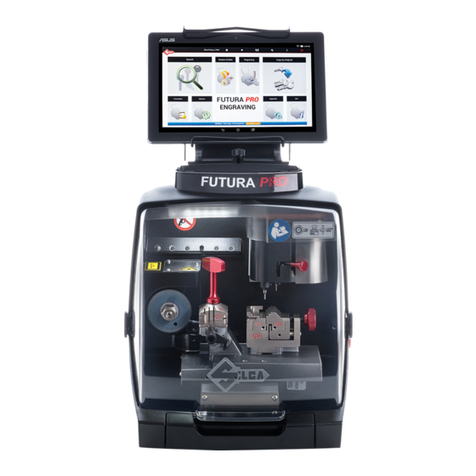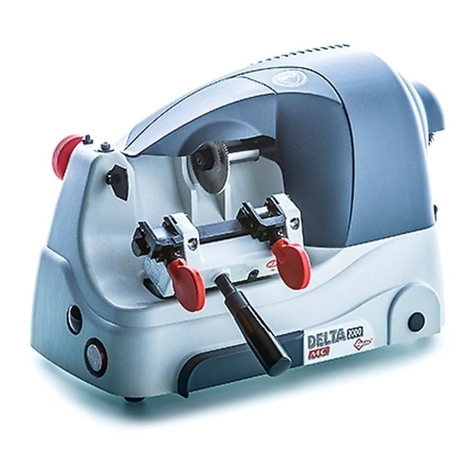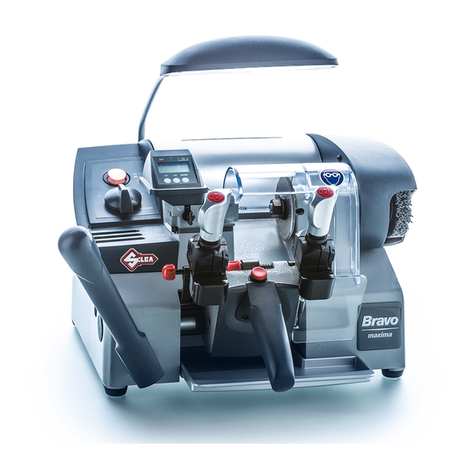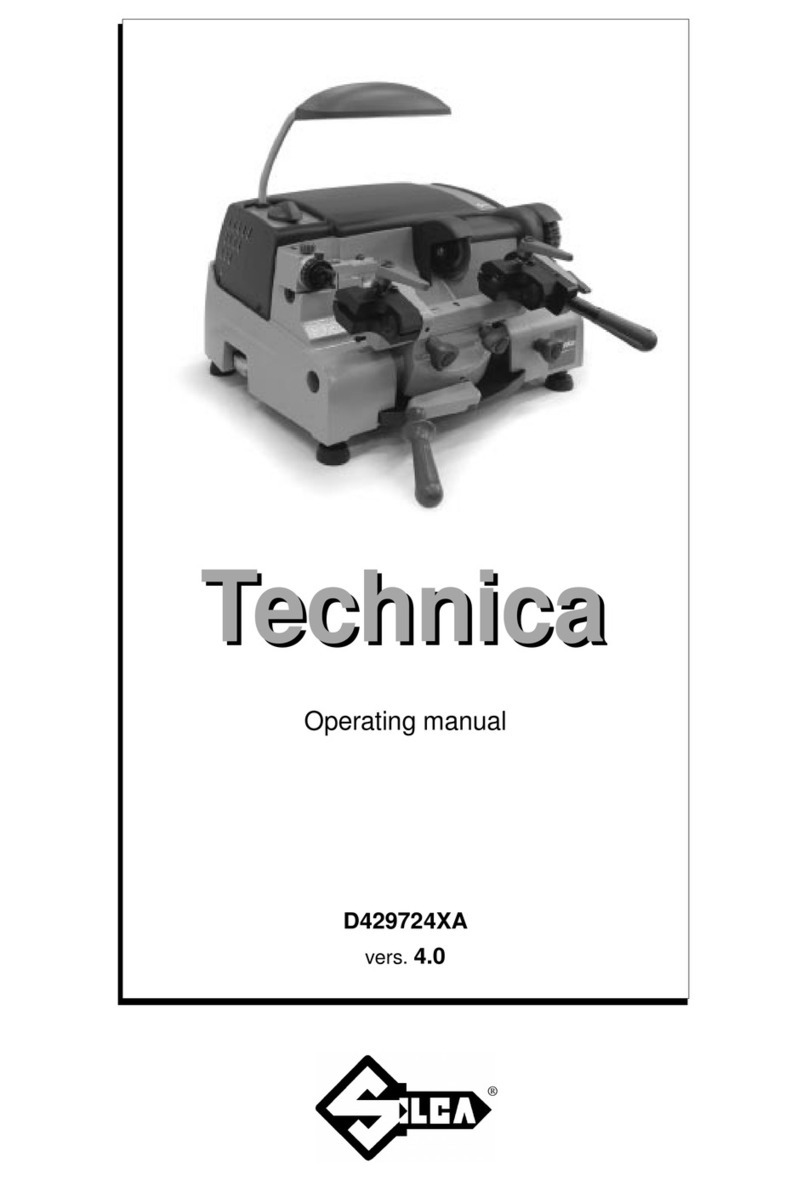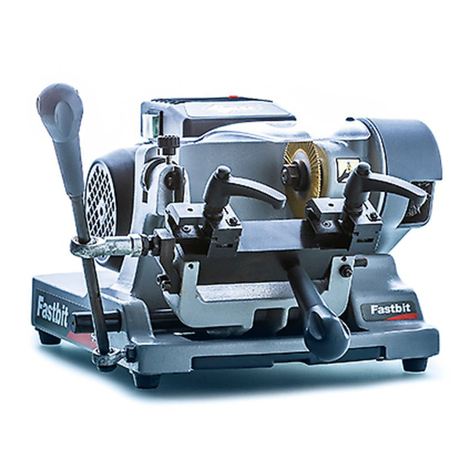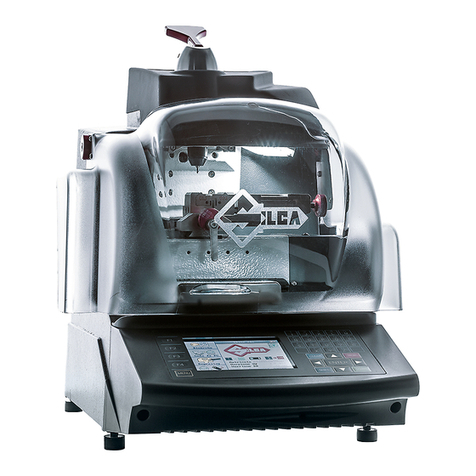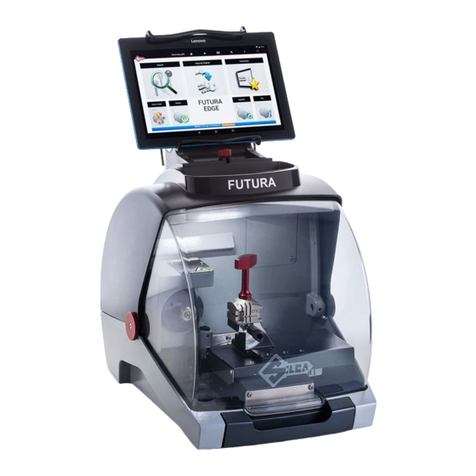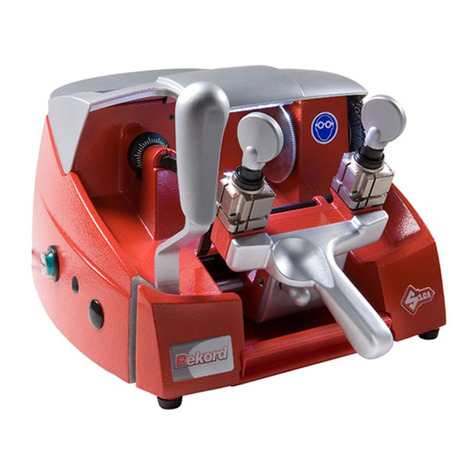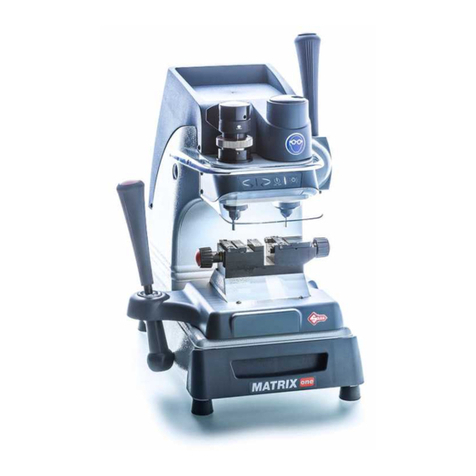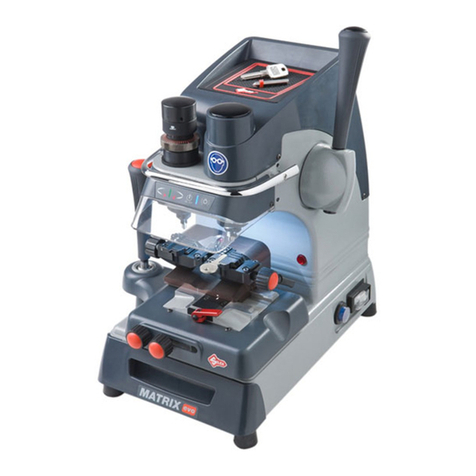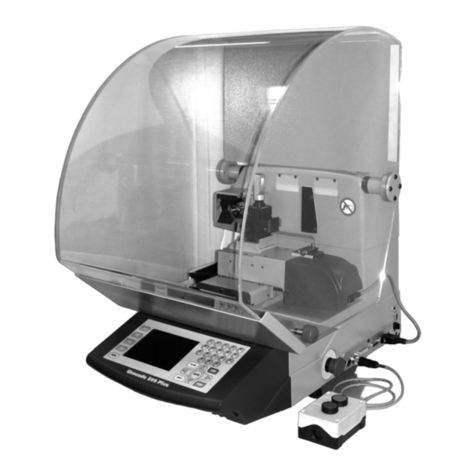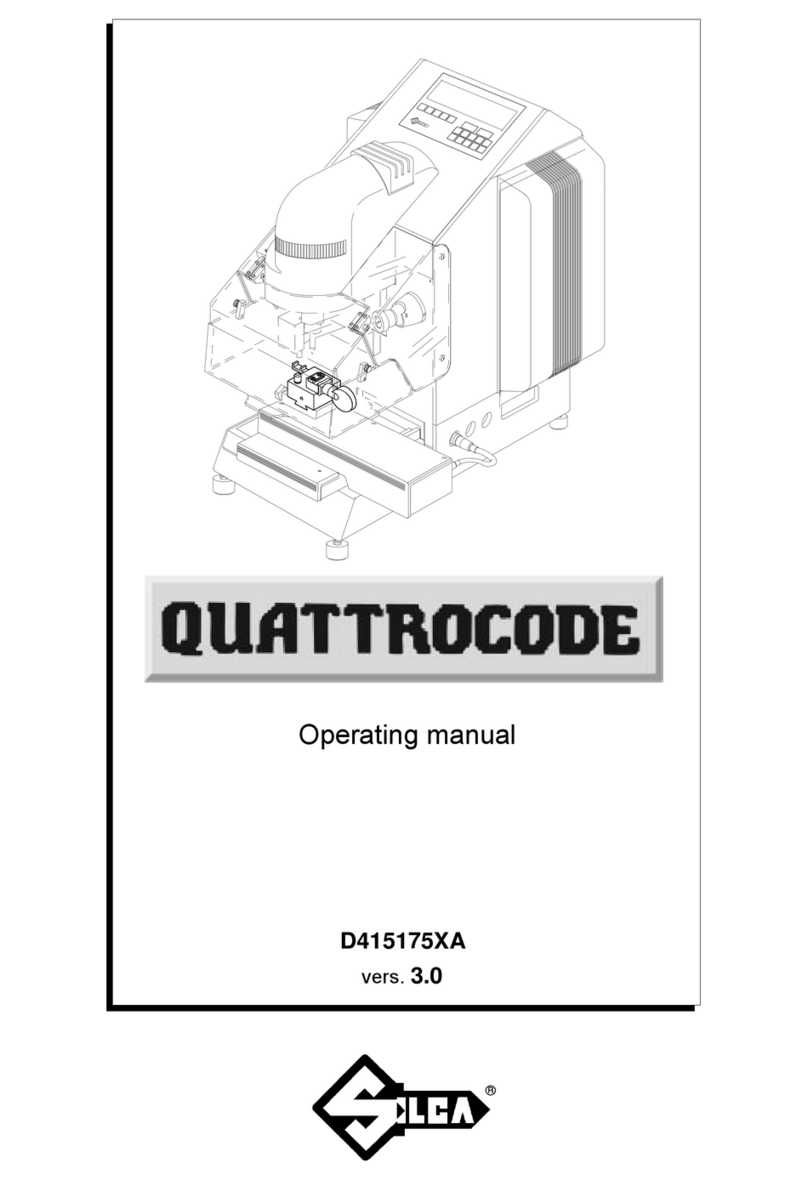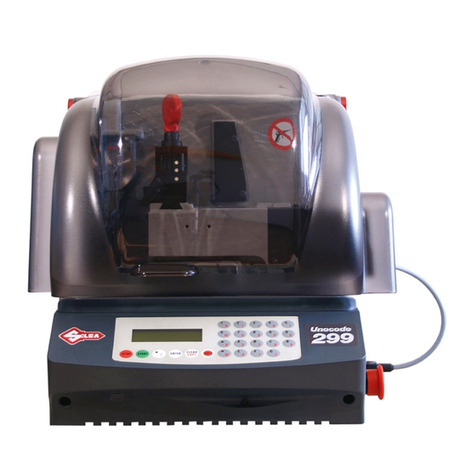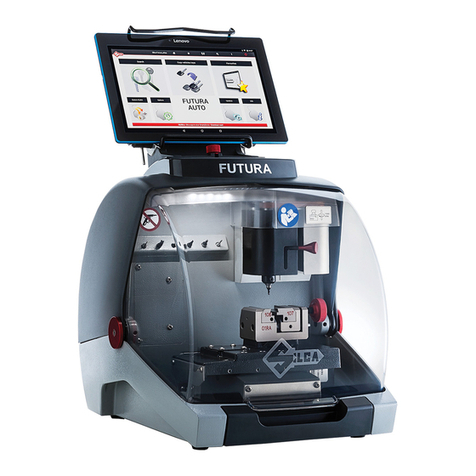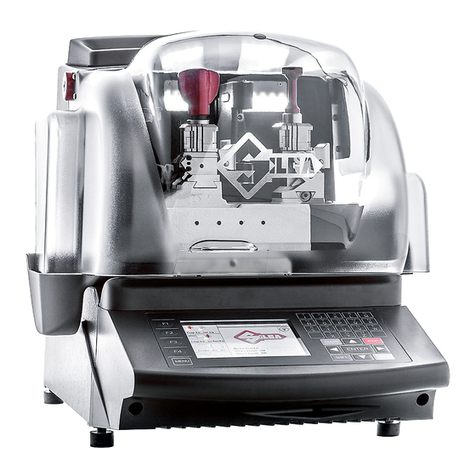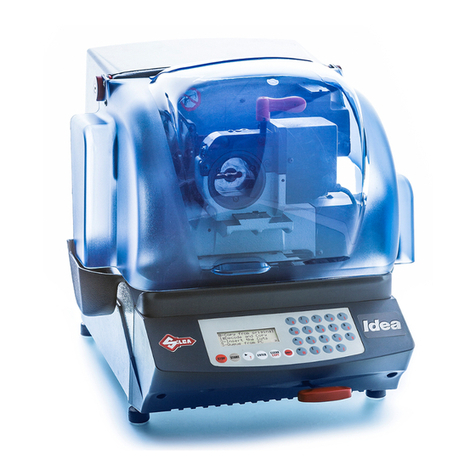
MANUTENZIONE
ATTENZIONE: in caso di riparazioni o sostituzione di pezzi per manutenzione, la marcatura "CE" e' garantita solo se vengono
utilizzate parti di ricambio originali fornite dal costruttore.
La duplicatrice non necessita di particolari manutenzioni, é comunque opportuno controllare ed eventualmente sostituire
alcune parti soggette ad usura quali: fresa, tastatore, cinghia di trasmissione e spazzola (se presenti).
Sostituzioni: le operazioni sono semplici e possono essere eseguite dall’operatore. I pezzi che devono essere smontati non sono
riposizionabili in modo errato o pericoloso.
Pulizia: si consiglia di tenere puliti carrello e morsetti da trucioli derivanti dalle cifrature utilizzando un pennello. ATTENZIONE: NON
USARE ARIA COMPRESSA!
ATTENZIONE: per una corretta manutenzione della macchina si suggerisce di utilizzare olio protettivo es. WD40 o Similari da
applicare alle parti meccaniche brunite, questo utilizzo previene l’ossidazione delle parti in questione (morsetti, guide,
carrelli...).
Prima di iniziare qualsiasi operazione di manutenzione leggere attentamente le seguenti avvertenze:
• non eseguire alcuna operazione con la macchina in funzione
• scollegare sempre il cavo di alimentazione
• usare pezzi di ricambio originali
SMALTIMENTO
Per il corretto smaltimento fare riferimento alle norme vigenti.
INFORMAZIONE AGLI UTENTI DI APPARECCHIATURE PROFESSIONALI
Ai sensi dell’art. 24 del Decreto Legislativo 14 marzo 2014, n. 49 "Attuazione della Direttiva 2012/19/UE
sui rifiuti di apparecchiature elettriche ed elettroniche (RAEE
)"
Il simbolo del cassonetto barrato riportato sull’apparecchiatura o sulla sua confezione indica che il prodotto alla fine della
propria vita utile deve essere raccolto separatamente dagli altri rifiuti per permetterne un adeguato trattamento e riciclo.
In particolare, la raccolta differenziata della presente apparecchiatura professionale giunta a fine vita è organizzata e gestita:
a) direttamente dall’utente, nel caso in cui l’apparecchiatura sia stata immessa sul mercato prima del 31 dicembre 2010 e l’utente stesso
decida eliminarla senza sostituirla con una apparecchiatura nuova equivalente ed adibita alle stesse funzioni;
b) dal produttore, inteso come il soggetto che ha per primo introdotto e commercializzato in Italia o rivende in Italia col proprio marchio
l’apparecchiatura nuova che ha sostituito la precedente, nel caso in cui, contestualmente alla decisione di disfarsi dell’apparecchiatura
a fine vita immessa sul mercato prima del 31 dicembre 2010, l’utente effettui un acquisto di un prodotto di tipo equivalente ed adibito
alle stesse funzioni. In tale ultimo caso l’utente potrà richiedere al produttore il ritiro della presente apparecchiatura;
c) dal produttore, inteso come il soggetto che ha per primo introdotto e commercializzato in Italia o rivende in Italia col proprio marchio
l’apparecchiatura nuova che ha sostituito la precedente, nel caso in cui l’apparecchiatura si immessa sul mercato dopo il 31 dicembre
2010;
L’adeguata raccolta differenziata per l’avvio successivo dell’apparecchiatura dismessa al riciclaggio, al trattamento e allo
smaltimento ambientalmente compatibile contribuisce ad evitare possibili effetti negativi sull’ambiente e sulla salute e favorisce
il reimpiego e/o riciclo dei materiali di cui è composta l’apparecchiatura.
Lo smaltimento abusivo del prodotto da parte dell’utente comporta l’applicazione delle sanzioni di cui alla corrente normativa di
legge.
SILCA ha scelto di aderire a Consorzio ReMedia, un primario Sistema Collettivo che garantisce ai consumatori il
corretto trattamento e recupero dei RAEE e la promozione di politiche orientate alla tutela ambientale
.
ASSISTENZA
Silca fornisce agli acquirenti delle sue duplicatrici un’assistenza tecnica adeguata.
Per una totale sicurezza dell’operatore e della macchina, ogni intervento non specificato nel manuale deve essere eseguito dal
costruttore o negli appositi Centri diAssistenza raccomandati da Silca.
A seguire sono riportati i centri diAssistenza specializzati Silca in tutto il mondo.
Modalità di richiesta di intervento
La cedola di garanzia allegata alla duplicatrice assicura interventi di riparazione o sostituzione gratuita di parti difettose nei 24
mesi successivi all’acquisto. Ogni altro intervento deve essere concordato dall’utente con Silca o con i suoi Centri di
Assistenza. Silca é comunque a Vostra disposizione per informazioni tecniche e chiarimenti.

